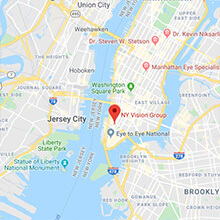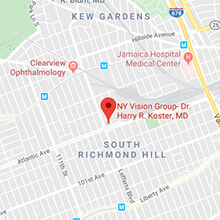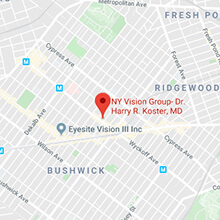Watch the video below to learn about a real patient’s vision correction experience!
Q: How long does LASIK take?
A: The procedure usually takes less than 5 minutes per eye. Actual laser treatment time is proportionate to the intended correction treatment and is usually between 5-15 seconds for most patients. Nonetheless, you should plan on being at the Koster Laser Suite at the NY Vision Group office at 37 Murray Street for approximately an hour-and-a-half on your day of surgery.
Q: Does LASIK hurt?
A: No. The actual treatment is painless. You will be given anesthetic eye drops to completely numb the eye and some patients are given a mild medication to decrease anxiety. You may feel a slight pressure sensation around your eye, and, after the procedure is finished, you may feel a sensation that our patients describe as gritty or like a lash in your eye for the first few hours.
Q: How long will it take to get my final result?
A: Although everyone is different, the vast majority of our LASIK patients achieve a legal driving vision, or better, the very next day. That is one of the most exciting advantages of the LASIK procedure; clear vision, quickly. Initially, your vision may fluctuate, usually as a result of dryness. This is perfectly normal. Vision should continue to improve gradually over the next few weeks.
Q: What side-effects can I expect from the procedure?
A: Minor side effects associated with the LASIK procedure do exist. Although postoperative pain is not commonly associated with the procedure, some patients feel minimum scratchiness for the first day or two. This is similar to the feeling of having a contact lens in the eye when you blink. Some patients may experience “halos”, glare, or light sensitivity around bright lights for a few days, or occasionally months, after the procedure. It may also take a short period of time to adjust to your close-up, or reading vision. These symptoms are expected, due to the normal post-operative swelling of your cornea, and will decrease during the first few weeks after the procedure. Side effects are fully discussed prior to a patient’s procedure.
Q: Can I drive myself home after the procedure?
A: Immediately after the procedure, your vision will be greatly improved but will not be crisp enough for you to drive safely. Please arrange to have a family member or friend escort or drive you home after the procedure and back in the next morning for your one-day post-op visit.
Q: When can I shower or go swimming after the LASIK procedure?
A: The basic answer to participating in activities after the LASIK procedure is “Use Common Sense”. You can shower the day after the procedure, but don’t spend prolonged time with your eyes open under rushing water. You can swim after three days, provided you wear goggles. In general, you should avoid rubbing your eyes for the first few weeks, avoid long periods with direct wind exposure and avoid swimming without goggles for the first month.
Q: Can you have LASIK on both eyes on the same day?
A: We typically perform LASIK on both eyes of a patient on the same day, although that decision should be made between you and your refractive surgeon. Because improved vision occurs so quickly, and the post-operative effects are minimal, treating both eyes at the same time makes sense to most of our patients.
Q: What is the difference between LASIK and Custom LASIK?
A: In the past, patients had to choose between traditional (or conventional) LASIK and Custom LASIK if they had difficult-to-pinpoint prescriptions (higher-order aberrations). At NY Vision Group, however, our new laser the WaveLight® EX 500 allows us to provide every patient with “Custom LASIK”. This laser, the most technologically advanced laser in the U.S. allows us to provide wave-front guided treatment for each patient, taking into account the specific shape and aberrations of each eye.
Q: Can children have LASIK?
A: No. The minimum age-range for Laser Vision Correction is 18 to 21. A person’s prescription must be stable, and children are likely to have their prescription change over time, just as their shoe size and their height changes with time.
Q: Is there a maximum age…am I too old to have Laser Vision Correction?
A: There is no real “maximum age” for LASIK. However, we would first need to determine that the overall health of your eyes is good and that your vision difficulties are not being caused by cataracts or some other eye disease. If LASIK is not a good option for you, there are other vision correction procedures, such as Refractive Lens Exchange or early cataract removal, that may be more appropriate. Furthermore, LASIK is an excellent procedure to correct prescriptions after cataract surgery.
Q: Will I need to wear reading glasses after this surgery?
A: As part of the natural aging process you may experience a change in your reading vision due to a weakening in the part of the eye known as the lens. The normally flexible lens loses its elasticity, ultimately resulting in a loss of ability to focus up close. This is known as presbyopia and is unaffected by refractive surgery, i.e., you may need reading glasses because of presbyopia whether or not you have LASIK.
Q: What if I blink during my LASIK procedure?
A: We take measures to ensure that blinking is not a problem. Your eye will be held open with a firm lid holder supporting your lid so that you cannot blink. The holder is placed immediately before the treatment and removed immediately afterward. The topical anesthetics used in your eyes also decrease your urge to blink tremendously.
Q: What if I move during the procedure?
A: The bed of the laser has a contoured headrest with an indent, which allows the back of your head to rest securely, but comfortably in place. During the treatment, Dr. Koster will gently hold your head in position and coach you to help keep your fixation steady. He also uses a focusing mechanism to assure that the treatment is precisely centered. Your job during the treatment will be to watch a blinking target light. While you are doing this, the laser’s computer will also be using its tracking system to monitor the position of your eye. The eye tracker monitors and responds to eye movements 100 times a second. If there is any movement greater than 2 millimeters the laser shuts down automatically.
For more information about LASIK in New York, please do not hesitate to contact our LASIK coordinator at 212.243.2300.




